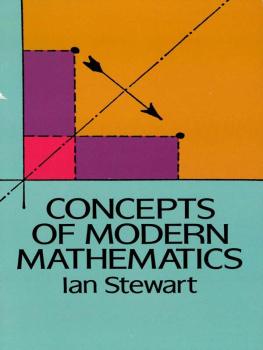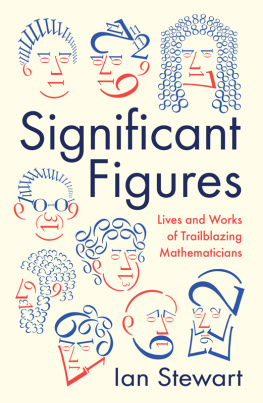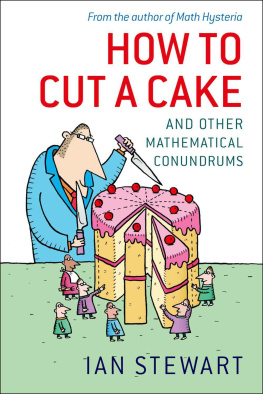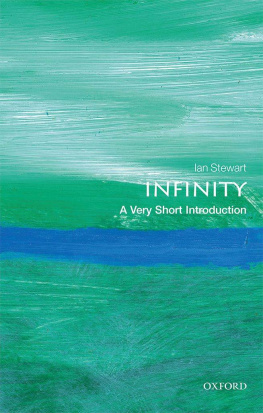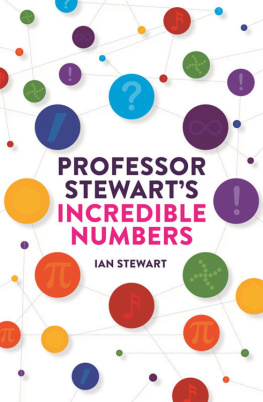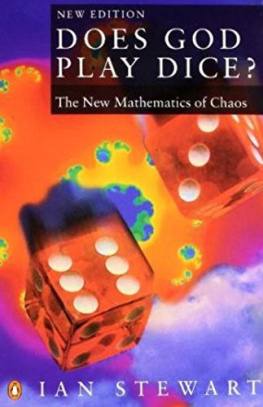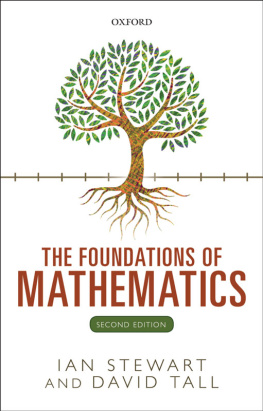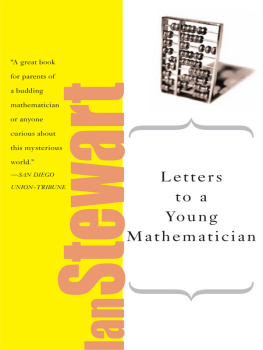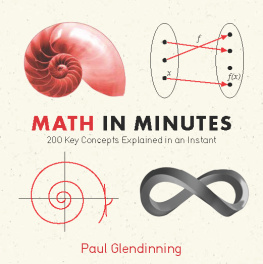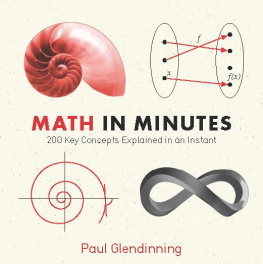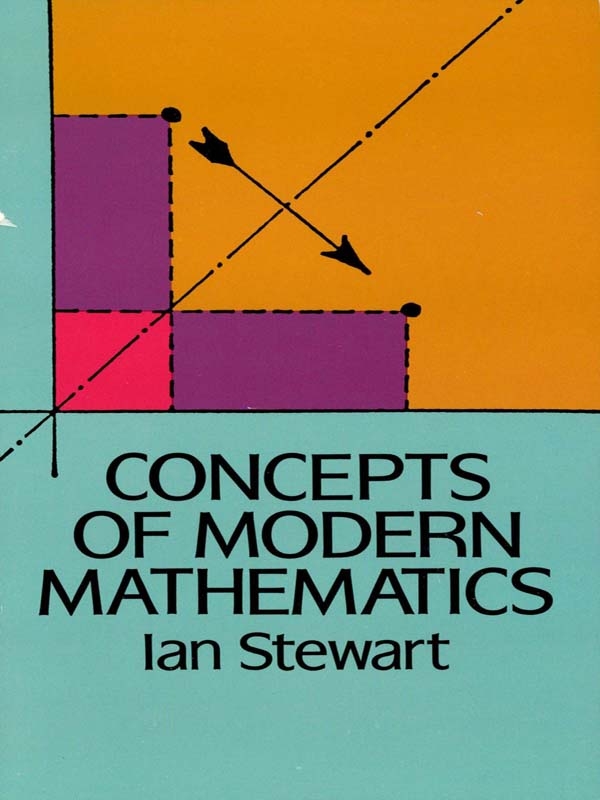The quotation in Chapter 2 from Winnie-the-Pooh by A. A. Milne, and that at the head of Chapter 9 from The House at Pooh Corner by A. A. Milne are reproduced with permission of the publishers, Methuen and Co. Ltd, and Mr C. R. Milne who holds the copyright. The quotation at the head of Chapter 4 from A Mathematicians Miscellany by J. E. Littlewood is reproduced with permission of the publishers, Methuen and Co. Ltd. The quotation at the head of Chapter 8 from Factor T by Stefan Themerson is reproduced with permission of the publishers, Gaberbocchus Press Ltd. The classification of surfaces in Chapter 12 is an abridged version of that given in Introduction to Topology by E. C. Zeeman (to appear) and is included with Professor Zeemans permission: however, any infelicities arising from the abridgement are my responsibility. To all of the above I express sincere thanks.
Appendix
And still it moves...
There is probably no other science which presents such different appearances to one who cultivates it and one who does not, as mathematics. To [the latter] it is ancient, venerable, and complete; a body of dry, irrefutable, unambiguous reasoning. To the mathematician, on the other hand, his science is yet in the purple bloom of vigorous youth
C. H. Chapman, in 1892
The reader who has persevered this far must by now be a cultivator of mathematics, even if he was not at the start of the endeavour. He will therefore appreciate that, while it may be ancient and venerable, it is far from complete; that not all of it is dry; and that its reasoning has not always been either unambiguous or irrefutable - nor is yet. Purple bloom and youthful vigour, however, may appear a trifle far-fetched; in any case, what was true in 1892 may not be today. My remark in Chapter 1 that most modern mathematics, as taught in schools, is over a century old, points to one possibility: if this truly were modern mathematics, one might conclude that the well had run dry. Fortunately it has not: the present century has witnessed the most rapid and broad advances of the subject in the history of humanity, as indeed it has in many other subjects.
So youthful is the vigour, indeed, that it has caused what might have been a minor embarrassment to your humble narrator. The first twenty chapters of this book were written in 19734 and published in 1975. It is now 1980. Even by 1977 several discoveries had been made which necessitated changes to those chapters. It would have been possible to do this by rewriting parts of them but it seemed better to make a virtue out of necessity, let what I wrote stand except for a few pointers toward this chapter, and add an appendix to update the information and, at the same time, demonstrate how rapidly mathematics is evolving.
It is neither feasible nor desirable to survey everything that has happened in those few years; just to catalogue the results would take a good many books the size of this one. My selection is strongly conditioned by links with the material discussed above. It cannot, therefore, be truly representative of the great variety of activities in which mathematicians indulge.
In Chapter 11 I unguardedly remarked, of the four-colour problem, that... it would be a pity if it were solved...: you might think that a problem that was posed in 1852 and unsolved in 1975 would have the decency to remain unsolved a little longer. It would seem, however, that the Principle of Universal Cussedness of Things (known by other, less flattering names) is in operation, for in mid 1976 a solution to the problem was announced. Although it is not quite certain that the proof is in the bag, for technical reasons that I shall mention, it looks as if it is. The next section of this chapter tells the story to date. Following that, we review recent work on polynomial formulae for primes, which among other things disproves something I said in Chapter 20. Finally, I want to expand on a point touched upon in Chapter 14; namely, the use of topology to study dynamical systems. Here some topological gadgets known as strange attractors have suddenly begun to manifest themselves in ecology, geology, and fluid dynamics, as a phenomenon that the ecologists have christened chaos. One result is that the line between deterministic and random behaviour cannot be drawn as clearly as has hitherto been widely assumed.
The Four-Colour Theorem
In Chapter 11 we had a four-colour problem and a five-colour theorem. On 22 July 1972 two mathematicians at the University of Illinois, Kenneth Appel and Wolfgang Haken, announced a proof that every map on the plane can be coloured with four colours, resolving the long-standing question. The snag with their proof is that it involves an immense amount of computing time - they used about 1200 hours, but a check might be performed in 300 on a big machine - and a single error might destroy the proof completely. Contrary to popular opinion, computers do make errors even when their programmers do not. The problems raised by this are as much philosophical as technical (is a proof checked by a human any more likely to be accurate than one checked by computer?) and look like causing some problems in future. At the present moment, the AppelHaken proof has not been fully checked by an independent program, although those parts that have been checked appear to be error-free. Philosophy apart, most mathematicians would probably agree that the theorem is proved provided such a check is carried out in full. The philosophical problem is an interesting one, however, because it involves the difference between a logical proof and a satisfactory one. I shall return to this once weve seen how it goes.
The proof of the five-colour theorem given in Chapter 11 is essentially due to A. B. Kempe (1879). Let us recall it briefly. It makes use of a reduction process (which involves a number of different cases) to show that the given map may be coloured provided another map, with fewer regions, can be coloured. By applying this process over and over again we must, since the number of regions decreases at each stage, eventually reach a map with as many or fewer regions than we have colours. This map is manifestly colourable, therefore reversing the reduction step by step, so was the previous one, and the one before that, and... the original.
Kempe went further than we have done (arguing for five colours): he added an argument purporting to prove that four would suffice (involving extra cases in the reduction). The mathematicians of the time seem to have accepted this proof without a qualm, until in 1890 P. J. Heawood pointed out the mistake. The proof we have given above, as Heawood also pointed out, remains valid for five -colourability.
The basic strategy of our proof for five colours and the Appel-Haken proof and even Kempes fallacious attempt - is the same. (Kempe simply failed to carry it out correctly.) For our present purposes this emerges more clearly if we recast our proof in a slightly different form. The idea is to argue by contradiction and suppose that there does exist a map requiring more than five colours. There is then such a map having the least possible number of regions (in trade jargon, a minimal criminal ), say M. By definition, every map with fewer regions than M can be coloured in five colours.
Next we show that M must contain at least one of a list of configurations, namely . Then we consider one of these configurations and concoct an argument of the following kind. From any map M which contains it, we show how to derive another map M with fewer regions. This M is so constructed that, if it is five-colourable, so is M. Thus the burden of colourability shifts from M to the simpler map M. (In our proof on pages 169-73, M is obtained from M by merging regions, as indicated.) We concoct such arguments (which may differ in detail) for each configuration in our list.

